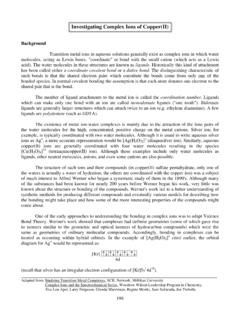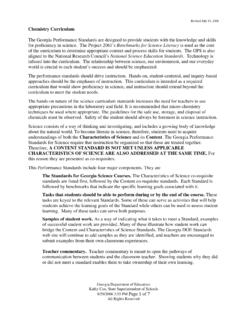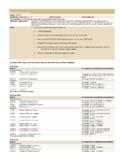Transcription of The Thermodynamics of the Dissolution of Urea
1 The Thermodynamics of the Dissolution of Urea Background We know that chemical reactions proceed with the evolution or absorption of heat. This heat flow represents differences in chemical energy associated with the rearrangement of atoms in molecules, the making and breaking of bonds to form new substances. When measured at constant pressure this is the enthalpy change ( H) for the reaction. Physical changes can also involve heat. Typically the dissolving of a solid in water will involve measurable heat. There is not absolute agreement on whether dissolving itself should be categorized as wholly physical, partly chemical, etc., but intermolecular forces are certainly involved (at the very least). Regardless of the appropriate "label" for dissolving as a process there is an overall energy term. It is known as the heat of solution, Hsoln. It may not be possible to know the precise mechanism for a particular Dissolution , but in a hypothetical generalized scenario there would be at least three energy changes involved: 1.
2 Solute particles are separated from the solid mass (energy is absorbed, H1). 2. solvent particles move apart to make space for dissolved solute (energy is absorbed, H2). 3. solute and solvent particles are attracted to one another (energy is released, H3). For most solids dissolving in water, the sum of the first two terms is greater than the third and thus dissolving is frequently endothermic ( Hsoln = +) and solubility generally increases with increasing temperature. When heats of solution become very highly positive it is often because the solute and solvent are dissimilar and, in the extreme case, immiscible. The old rule of "like dissolves like" is an approximation, but a good one. The urea-water system involved in this experiment is an interesting one because it involves a sequence of enthalpy and entropy trade-offs due to the presence of strong intermolecular forces: hydrogen bonding. Urea, an amide, has the following structure: O. C. H2N NH2. [Historically urea is a compound of some importance.]
3 In the early days of what became organic chemistry there were many who believed that organic compounds could not be synthesized in the laboratory from inorganic ingredients. Organic compounds were thought to contain a "vital force" (decidedly non-chemical) but in 1828, Friedrich W hler (then 28 years old) accidentally prepared urea by heating ammonium cyanate (an inorganic compound). This event opened the door to the development of modern synthetic organic chemistry.]. Because of the electronegativity of the nitrogen atom, hydrogen bonding is possible at both N-H. sites in the urea molecule. There is also respectable polarity at the C=O bond and additional interactions can occur there. Urea is therefore a polar molecular solid. Its melting point is 133oC. Adapted from The Entropy of Dissolution of Urea, Miles Pickering, J. Chem . Ed., 1987, vol. 64, p. 723. 164. The melting point of urea suggests that fairly strong forces bind the molecules together in the solid. These forces must be overcome if the solid mass is to separate during dissolving.
4 Clearly this part of the Dissolution process should be endothermic ( , H1 = +). The second step in the dissolving "process" is the disruption of the semi-structure in the solvent to make space for the solute molecules to disperse and enable the formation of a mixture. Urea molecules are not the same size as water molecules as the scale diagrams below show. In the jostling of water molecules that would occur normally at room temperature hydrogen bonds are breaking and forming constantly and molecular clusters of various sizes come and go. But the insertion of urea molecules into this mix requires more space between the water molecules and that means added potential energy. This part of the Dissolution process is therefore also endothermic ( H2 = +). The final step in the rather artificial solution formation process described earlier is the interaction between solute and solvent which results in the actual solution forming. In the case of urea and water the situation looks very promising.
5 Both substances are polar, both can hydrogen bond, and while urea is somewhat larger than water it is not grossly out of scale. We might expect fairly strong interactions between the molecules and that means H3 should be negative. The hard part, of course, is to guess the relative magnitudes of these steps, , whether the overall process will be endothermic or exothermic. If we "guess" that the breaking of hydrogen bonds in solid urea is roughly equivalent to the making of hydrogen bonds in the urea-water solution then the second step (which is somewhat endothermic) might determine the overall heat of solution. Experimentally, this is easy to settle by a simple calorimetry experiment. Urea is quite soluble in water (1 g in 1 mL) so there is no question as to the spontaneity of the process at room temperature. This tells us something else about the dissolving of urea in water: the entropy change in the universe is positive. 165. When solids dissolve in liquids the entropy of the system nearly always increases.
6 This is owing mainly to the increased freedom of movement of the solute particles as the forces which hold the solid together are overcome. When the urea molecules are trapped in the solid lattice they can only vibrate in place and these vibrational motions are limited by near neighbors. In addition, vibrational energy states are fairly far apart so the options are few at room temperature. Dispersed in the solvent, the molecules can translate and rotate as well as vibrate. The energy states for the many possible translational and rotational motions are more closely spaced than those for the vibrational states. Therefore with increased movement comes the possibility of more of those motions such as make IR spectra so complex and which aid in the dispersal of energy. Dispersal of energy is what entropy is all about. So the entropy change for the first step in our dissolving "process" is positive ( S1 = +). Also occurring in the system, the solvent molecules must move about to make space for the solute.
7 In general this results in disruptions of the solvent-solvent forces and more freedom of movement for the solvent molecules, hence additional pathways for energy dispersal. So S2 is typically positive. In the final step solvent and solute interactions decrease the free movement of both species to some extent and the entropy may decrease. This leaves two unknowns: what are the relative magnitudes of these three steps which occur in the system AND what about Ssurr? The question about Ssurr takes us back to the question about the overall Hsoln (actually Hsys). since the flow of heat between the system and the surroundings will determine Ssurr. If heat moves into the surroundings then the entropy there will rise. If the heat flow is in the other direction then Ssurr will be negative. Urea certainly dissolves and therefore: Ssys + Ssurr >0. But if the solvent-solute interactions are strong enough, Hsys ( , Hsoln) might be negative. This would make Ssurr positive but would also tend to make S3 more negative.
8 If, on the other hand, Hsys were positive, then Ssurr would be negative and so S1 + S2 > | S3 + Ssurr|. As already mentioned, it is possible to find the heat of solution in the lab but determining the entropy of solution ( Ssoln) is a more complicated matter. This is true for most entropy determinations, which are typically indirect. In this experiment the thermodynamic requirements for the equilibrium condition can be exploited to determine Ssoln from the readily found heat of solution and the free energy change. In a saturated solution of urea the following equilibrium exists: urea(s) ' urea(aq). The equilibrium constant expression for this reaction is: [urea(aq)]. Kc =. [urea(s)]. 166. Because the solid has unit activity (and a constant concentration) it is generally not given as part of the constant so this expression may be written simply as: Kc = [urea(aq)]. We know that the relationship between the equilibrium constant and the standard free energy change is: Go = -RT ln Kc where R = J/mol K and T is in kelvins.
9 If the concentration of urea in a saturated solution can be determined then Kc is known and it is possible to calculate the free energy change for the dissolving of urea (or at least an approximation of Go). Combined with the heat of solution from a calorimetry experiment this allows the calculation of Ssoln since: Gsoln = Hsoln - T Ssoln The measurement of urea concentration can be done by a variety of methods. In this experiment we will use an adaptation of a colorimetric method employed in clinical medicine for determining "blood urea nitrogen" (BUN). This assay is so sensitive that the saturated urea solution has to be diluted 20,000-fold to give a suitable concentration. The diluted urea solution is combined with a test reagent which consists of an acidic solution of diacetyl monoxime and some additional minor constituents. In acidic solution the monoxime hydrolyzes to give 2,3-butanedione (which is otherwise unstable): CH3 CH3. +. HO C O H C O. N C O C + HON2. CH3 CH3. Upon warming, a condensation reaction occurs with the urea in the solution: O.
10 CH3 O. C. C O C N N. O C + H2N NH2. + 2 H 2O. C C. CH3. H3C CH3. The resulting five-membered ring compound is pink. One of the other minor constituents in the test reagent intensifies the color in some unspecified way. The intensity of the color is proportional to the concentration of urea so that a comparison can be made with standards in accordance with Beer's Law. 167. The Experiment There are three parts to this experiment: determination of the heat of solution for urea in water determination of the specific heat of the urea solution determination of the urea concentration in a saturated solution The following non-locker materials will be provided: solid urea expanded polystyrene calorimeter CBL w/thermometer probes matched pair of resistance-heater calorimeters w/power supply and cable saturated urea solution [record temperature from label]. 100 mL volumetric flasks micropipettor w/tips 4 urea solution standards [record concentrations from labels]. six 13 x 100 mm test tubes in rack Fisher Model 415 Spectrophotometer w/cuvettes BUN reagent The Chemicals Urea consists of white, tetragonal prisms.








